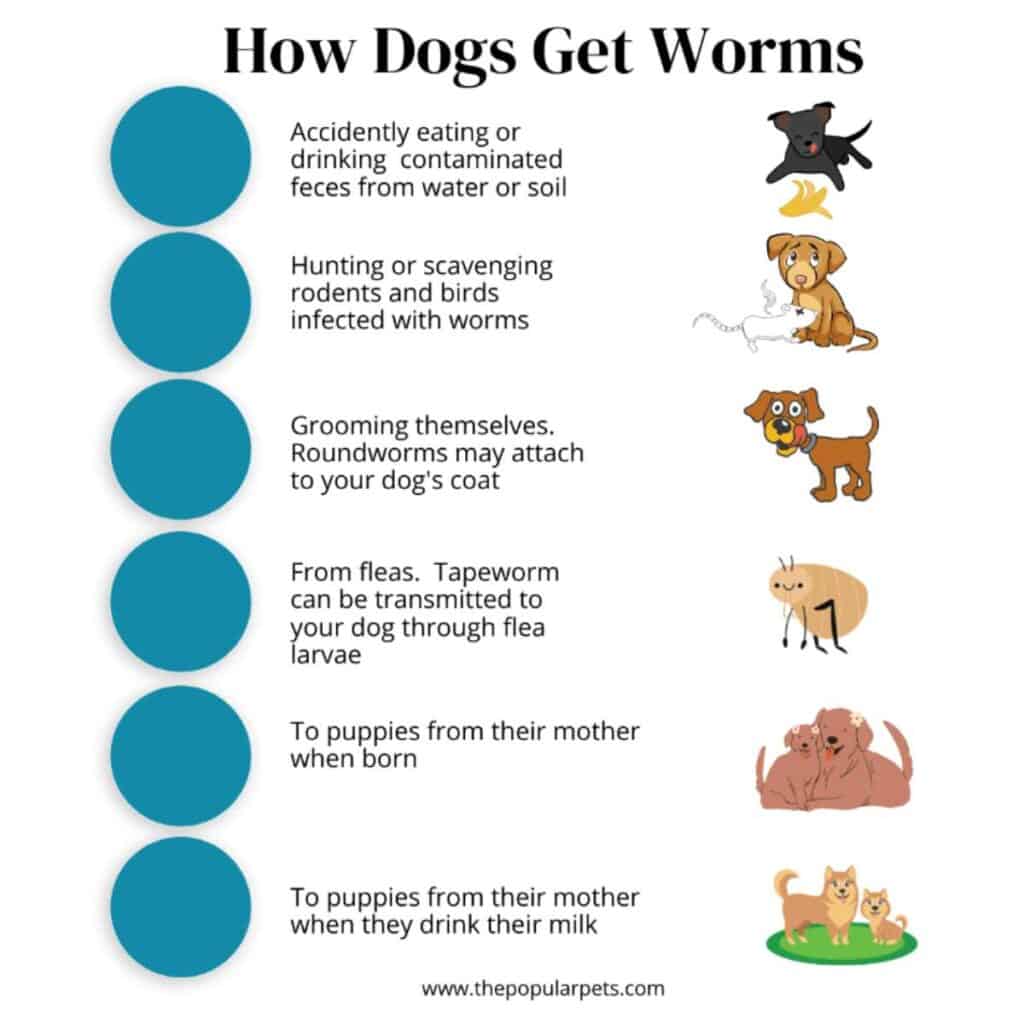We all love our dogs so when it comes to dog diseases, we need to be vigilant, so our dogs remain in optimum health. Dog worms or parasites can undermine the optimum health of your dog since your furry companion may look healthy on the surface but have worms that affect their well-being. Nasty parasites or worms may jeopardize all that you do to keep your dog healthy.

It is important to understand how to tell if your dog has worms and the signs and symptoms of worms in dogs. This article will tell you all about what worms are, plus the signs and symptoms of worms in dogs along with their treatments.
What Are Worms and Why Are They Dangerous For Dogs?
Worms are very common for dogs, especially puppies. Worms are parasites that can live in the intestines of animals, including dogs. They steal nutrients from their host and can cause a wide range of health problems, including weight loss, diarrhea, anemia, and disease associated with these issues and even death.
There are many different types of worms that can infect dogs, but the most common are roundworms, hookworms, heartworms, and tapeworms. All of these worms can cause disease and zoonotic infections which are dangerous and can be deadly if left untreated.
Further, dog worms can transfer to people see the article Do Dog Worms Transfer to Humans here. That’s why it’s important to have your dog checked for worms regularly and to give them regular worming treatments if necessary.

What Causes Worms In Dogs?
Most people are familiar with the common types of worms that affect dogs. Still, many don’t know how these parasites end up in their pet’s systems. Though dogs can become infected in a few different ways, the most common cause is ingesting infected feces. This can happen if your dog sniffs around or eats something it shouldn’t while out on a walk or if your dog drink from a puddle or lake that contains contaminated water.

Another way dogs can get worms is by coming into contact with an infected animal. This can happen if your dog plays with an infected dog, gets fleas from that dog, or is around the dog’s contaminated feces.
Dogs can also get worms from fleas. If a dog has fleas, it may also have tapeworms. Fleas transfer tapeworm eggs to your dog’s blood through their bite, Or it can also be transferred when the flea has been swollen by dogs when they lick or chew on their fur. The tapeworm (larvae) then attach to the wall of your dog’s intestine and continue growing to maturity.
Puppies can be born with worms if their mother had them while she was pregnant, or later get them in their mother’s milk. Lastly, worms can even be transmitted to dogs through mosquito bites.
No matter how your dog gets them, it’s important to know the signs of worms so you can get them treated quickly.
Symptoms or Signs Of Worms in Dogs
There are a few different symptoms that you might see if your dog has worms. These Include:
- Your dog has a sudden change in appetite.
- Your dog has pneumonia or Intestinal blockage.
- Your dog is losing weight inexplicably, despite having a good appetite.
- Your dog has diarrhea or increased stool volume, which may be bloody or contain mucus.
- Your dog vomiting worms (or seeing them in your dog’s vomit) is a sure sign of an infestation.
- Your dog may be coughing or wheezing more than usual.
- Your dog has a dull coat as the parasites steal nutrients from their host, and your dog may shed more than usual.
- Your dog may feel abdominal pain.
- You see worms (that look like rice grains) attached to the fur around their bottom or found in your dog’s stool when you clean up after them.
- Your dog may have difficulty breathing.
- You notice your dog scratching its butt more than usual.
- You notice your dog has a Pot-bellied appearance (black skin with scarce hair).
- Your dog has Lethargy (sometimes described as extreme tiredness).

Sometimes worms show few to no signs, Keep your eyes open for any or all of these changes in your dog’s daily health and appearance. If you notice any of these signs, you must take your dog to the vet as soon as possible. The vet can confirm whether or not your dog has worms or you can order your own worm test for dogs.
Types Of Worms That Can Affect Your Dog and the Symptoms of Worms in Dogs
As any pet parent knows, keeping your dog healthy and free of parasites is important. And while most of us are familiar with the idea of fleas and ticks and the importance of dog grooming not as many of us are aware of the danger that worms can pose to our furry friends or their housemates (aka cats).
There are a number of different types of worms that can infect dogs, and each one comes with its own set of symptoms of worms in dogs and dangers. Here’s a quick rundown on the most common types of worms in dogs and their symptoms what you should do if you think your pup may be infected:
Roundworms in Dogs and Symptoms
Roundworms are usually transmitted through contaminated food or water. They can also be passed on from mother to puppy during pregnancy or nursing. They’re typically white or light-colored and look like spaghetti noodles. Symptoms of roundworm include:
- Weight Loss
- Diarrhea
- Vomiting
- A Pot-Bellied Appearance
Tapeworms in Dogs and Symptoms
Tapeworms are flat, segmented worms that live in the intestine and can grow up to 8 inches long. They’re usually transmitted to dogs by ingesting a host that contains tapeworm. You may also see segments of the tapeworm in your dog’s stool or around his anus. Symptoms of tapeworms include:
- Itching
- Scooting and chewing at the rear end
Hookworms in Dogs and Symptoms
Hookworms are also common in the soil and the grass of the farm. This worm can be transmitted to the dog when playing with the soil or walking on the ground, and they are not usually visible to the naked eye. Symptoms of hookworm include:
- Anemia
- Severe blood loss
- Lethargy
- Diarrhea
Whipworms in Dogs and Symptoms
These parasites live inside the dog’s intestine and pass eggs in the feces. They can be passed from mother to puppies in utero or through the birth canal and can also be found in the environment. The infection is transmitted through the fecal-oral route, which means the dog eats something contaminated with the worm’s eggs. This worm is rarely seen on its own but can be seen in a number of diseases in dogs. Symptoms of whipworms include:
- Reduced Appetite
- Chronic weight loss
- Bleeding and mucous in the stool
No matter the worms that affect your dog checking for worms regularly is extremely important not only to provide peace of mind for the safety of your family but for the health and longevity of your dog.
Dog Worm signs and Symptoms FAQs
There are many signs and symptoms of worms in dogs which include diarrhea, vomiting, weight loss, particularly if your dog is otherwise eating well, a bloated belly or generally “unhealthy” appearance, a dull, dry coat, excessive scooting and chewing at their bottom.
You will likely notice that your dog is more lethargic if it has worms as the worms will uptake important nutrients and stress the body. your dog may also vomit and scoot.
If you suspect worms you can always test for your dog for worms before administering any deworming medicine. It is important to test dogs before administering dog de-wormer avoid adding anything to your dogs system that is not necessary and to ensure what worms you need to treat. There are natural de-wormers like Diatomaceous earth 1 tbp a day for 10 days has worked for us along with over the counter dewormers like these on Amazon.
Yes, certain dog worms can transfer to humans learn more here.
Looking to learn more about taking charge of your Dog’s Health? Learn about Pet Testing from The Popular Pets. Now offering pet testing for your the health of your pet and your peace of mind. Learn more about pet testing options.
You may also be interested in the Ultimate Guide to Heartworm
Diatomaceous Earth for Dogs and Cats FAQ
Diatomaceous earth is great for dogs and is safe to ingest and put on their skin, sniffing diatomaceous earth is not a problem but dog owners do need to be careful that dogs do not inhale DE further. The silica in DE can be harmful to dog and cat lungs, especially pets with respiratory issues. The many benefits of DE make it a useful pet wellness tool.
Since DE is an excellent addition to food due to its ability to kill parasites, bind collagen and support a healthy coat and joints, licking DE is not only beneficial but suggested. DE is safe for dogs but dog lovers should get food grade DE to be safe.
Diatomaceous earth will not harm dogs. DE is non-toxic and actually helpful for dogs due to its many wellness attributes. Pet lovers have found many benefits to adding DE to their pet’s food to help support a healthy coat and fend off parasites and on externally to help with fleas and ticks.

